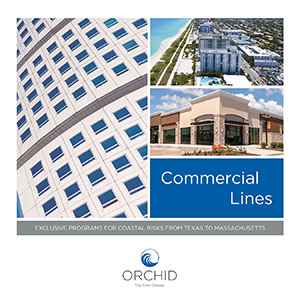After Hurricane Ivan damaged their coastal home in Pensacola, Fla., in 2004, Calvin and Elizabeth Moore went to work, shoring up the roof and windows. The upgrades did little to prevent significant damage some 15 years later when Hurricane Sally struck. While workers repainted and dealt with mold inside the house from a leaking roof, the couple spent months sleeping in the sitting area of their kitchen.
To their credit, the Moore’s were able to salvage some of their antiques, art, and furniture by safely removing them from their home before Hurricane Sally released its wrath. But damage was hard not to avoid – roughly $300,000 in repair costs on their 4,000-square foot home, which faces water on three sides. If there is a lesson to be learned for the Moores and residents who own coastal properties like them, it could have been much worse.
Chad Gibbons, an underwriting manager, at Orchid Insurance, which offers coverage solutions for coastal risks from Texas to Massachusetts, said it is imperative that homeowners acquire adequate property insurance in advance of a severe storm.
“The best way for an agent to strengthen a client relationship and relieve some of the stress and anxiety prior to hurricane season is to review their policy with them to ensure they have the right protection,” said Gibbons. “Take some time to make sure the coverage will provide for the actual replacement cost of their home and personal property. And, if the client does not have flood insurance, think about adding the coverage to an existing policy.”
Prepare Now
Gibbons said agents should advise homeowners on what additional coverages they might need to guard against a hurricane, such as windstorm deductibles. Unlike the fixed dollar deductibles assigned to damages from a fire, plumbing or theft in a primary policy, windstorm deductibles amount to a percentage of the total insured value of a home. Depending on the location, the level of these percentages can range from 1-5 percent. The greater the risk of wind damage, the higher the percentage.
Weather forecasters have begun to predict an above-average level of tropical cyclone activity during the 2021 hurricane season, which begins June 1 and runs through Nov. 30. Already, researchers at the Department of Atmospheric Science at Colorado State University, anticipate 17 named storms, eight hurricanes and four major hurricanes during the 2021 season. A typical year has 12 named storms, six hurricanes and three major hurricanes.
Orchid Insurance encourages property owners to prepare now. By following Orchid’s hurricane prep list, homeowners can limit wind and water damage to their homes and ensure they are reimbursed for anything lost:
Protect Your Property
- Declutter drains and gutters.
- Install check valves in plumbing to prevent backups.
- Review insurance policies to ensure you have flood coverage.
- Protect all openings as best you can, such as impact glass, shutters, or pre-cut plywood.
- Keep important documents in a safe place or create password-protected digital copies.
- After seeing the many instances of flooding in recent years, it is more important now than ever to inquire about flood coverage. Acting today can make a difference after a storm. Do not wait until it is too late. Call your agent today to ensure you have purchased the proper coverage you and your family need in the event of a storm.
Survive the Storm
- If told to evacuate, do so immediately. Do not drive around barricades.
- If sheltering during high winds, go to a FEMA safe room, ICC 500 storm shelter, or a small, interior, windowless room or hallway on the lowest floor that is not subject to flooding.
- If trapped in a building by flooding, go to the highest level of the building. Do not climb into a closed attic. You may become trapped by rising flood water.
- Listen for current emergency information and instructions.
- Use a generator or other gasoline-powered machinery outdoors ONLY and away from windows.
- Do not walk, swim, or drive through flood waters. Turn Around. Do not Drown! Just six inches of fast-moving water can knock you down, and one foot of moving water can sweep your vehicle away.
- Stay off bridges over fast-moving water
Making an Insurance Claim
- Document any property damage with photographs or videos.
- Contact your insurance agent or insurer as soon as you can. Provide a general description of the damage and have your policy number handy if possible. Write down the adjuster’s name, phone number and work schedule as soon as you have them. ***
- Prepare a list of damaged or lost items for your adjuster. ***
- If you need to relocate, keep records and receipts for all additional expenses. Most insurance policies cover emergency living arrangements. ***
- After your insurance company has been notified of your claim, they must send you the necessary claim forms within a certain number of days (time periods varies by state). Fill out and return the forms as soon as possible. If you do not understand the process, be sure to ask questions and write down the explanation. ***
*Source: https://www.ready.gov/hurricanes
**Source: https://www.chubb.com/us-en/claims/hurricane-windstorm-personal-preparedness-planning.aspx
***Source: https://disastersafety.org/hurricane/after-a-hurricane-safety-tips/




